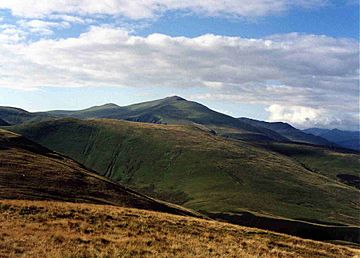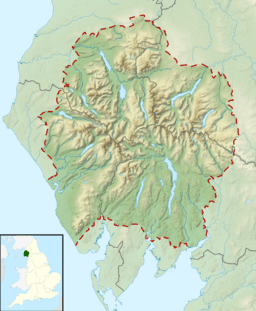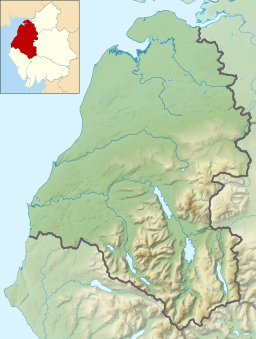Great Cockup facts for kids
Quick facts for kids Great Cockup |
|
|---|---|

Great Cockup seen from Longlands Fell with the bulk of Skiddaw behind.
|
|
| Highest point | |
| Elevation | 526 m (1,726 ft) |
| Prominence | c. 85 m (279 ft) |
| Parent peak | Knott |
| Listing | Wainwright |
| Geography | |
| Location | Cumbria, England |
| Parent range | Lake District, Northern Fells |
| OS grid | NY273333 |
| Topo map | OS Landranger 89, 90 OS Explorer 4 |
Great Cockup is a fell (a type of mountain or hill) located in the northern part of the English Lake District. It's one of the four Uldale Fells, along with Longlands Fell, Great Sca Fell, and Meal Fell.
Contents
What is Great Cockup?
Great Cockup stands at 526 meters (about 1,726 feet) tall. It's even mentioned in a famous guide by Alfred Wainwright, called Pictorial Guide to the Lakeland Fells. Wainwright described the fell as more useful than beautiful. He said it looks like a simple, wide hill from far away, without a clear top. He also felt it wasn't very exciting up close.
How Did Great Cockup Get Its Name?
The name 'Great Cockup' helps tell it apart from its smaller neighbor, Little Cockup. Little Cockup is 395 meters (about 1,296 feet) tall and is found on Great Cockup's northwestern side, near the village of Orthwaite.
The name comes from old English words. Cocc meant a woodcock or black grouse, which are types of birds. Hop meant a hidden or quiet valley. So, the name likely means 'the larger fell above the quiet valley where woodcock or black grouse are found'. It's thought that the valley's name was later used for the hills too.
Exploring Great Cockup's Landscape
On the western side of Great Cockup's summit, you can find old stone structures. These were once grouse butts, used by hunters to hide. Some of them have fallen apart, leaving only their foundations. This can sometimes make walkers confused about what they were.
Lower down on the southern side of the fell, there's a large, single rock. It's so big it's marked on detailed maps! This rock is believed to be a glacial erratic. This means it was carried there by a moving glacier long ago and left behind when the ice melted. Scientists have also found rare fossils on the slopes of Great Cockup. These fossils include unusual forms of ancient sea creatures called dendroid graptolites.
How to Climb Great Cockup
Most people start their climb of Great Cockup from the small village of Orthwaite. They follow a path called a bridleway up a stream called Hause Gill for about 2 kilometers (1.2 miles). From there, they leave the path and climb the steep southern slopes to reach the top.
You can also try climbing over Little Cockup first. However, the plant called bracken can grow very thick there during certain times of the year, making it harder to walk through. Great Cockup is separated from Meal Fell, which is about 1.5 kilometers (1 mile) to the east, by a mountain pass called Trusmadoor.
Views from the Summit
From the very top of Great Cockup, you get a great view of Skiddaw's northern slopes. You can also see far away towards the Scottish Borders, which is the area between England and Scotland.



